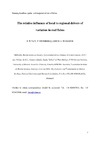Please use this identifier to cite or link to this item:
https://accedacris.ulpgc.es/handle/10553/9897
| DC Field | Value | Language |
|---|---|---|
| dc.contributor.author | Tuya, F. | en_US |
| dc.contributor.author | Wernberg, T. | en_US |
| dc.contributor.author | Thomsen, Mads S. | en_US |
| dc.date.accessioned | 2013-04-06T05:00:20Z | - |
| dc.date.accessioned | 2018-02-21T14:17:00Z | - |
| dc.date.available | 2013-04-06T05:00:20Z | - |
| dc.date.available | 2018-02-21T14:17:00Z | - |
| dc.date.issued | 2011 | en_US |
| dc.identifier.issn | 0022-1112 | en_US |
| dc.identifier.other | WoS | - |
| dc.identifier.uri | https://accedacris.ulpgc.es/handle/10553/9897 | - |
| dc.description | La versión definitiva del documento en www3.interscience.wiley.com | - |
| dc.description.abstract | In this study, fishes and habitat attributes were quantified, four times over 1 year, on three reefs within four regions encompassing a c. 6 degrees. latitudinal gradient across south-western Australia. The variability observed was partitioned at these spatio-temporal scales in relation to reef fish variables and the influence of environmental drivers quantified at local scales, i.e. at the scale of reefs (the number of small and large topographic elements, the cover of kelp, fucalean and red algae, depth and wave exposure) and at the scale of regions (mean and maximum nutrient concentrations and mean seawater temperature) with regard to the total abundance, species density, species diversity and the multivariate structure of reef fishes. Variation in reef fish species density and diversity was significant at the regional scale, whereas variation in the total abundance and assemblage structure of fishes was also significant at local scales. Spatial variation was greater than temporal variation in all cases. A systematic and gradual species turnover in assemblage structure was observed between adjacent regions across the latitudinal gradient. The cover of red algae within larger patches of brown macroalgae (a biological attribute of the reef) and the number of large topographic elements (a structural attribute of the reef) were correlated with variation observed at local scales, while seawater temperature correlated with variation at the scale of regions. In conclusion, conservation efforts on reef fishes need to incorporate processes operating at regional scales with processes that shape local reef fish communities at local scales. | en_US |
| dc.format | application/pdf | - |
| dc.language | eng | en_US |
| dc.relation.ispartof | Journal of Fish Biology | en_US |
| dc.rights | by-nc-nd | - |
| dc.source | Journal of fish biology [ISSN 022-1112], v. 79, p. 217-234 | en_US |
| dc.subject | 241705 Biología marina | en_US |
| dc.subject.other | Spatial patterns | en_US |
| dc.subject.other | Variability | en_US |
| dc.subject.other | Reef fish assemblages | en_US |
| dc.subject.other | Diversity | en_US |
| dc.subject.other | Macroecology | en_US |
| dc.subject.other | Australia | en_US |
| dc.subject.other | Temperate Reef | en_US |
| dc.subject.other | Canarian Archipelago | en_US |
| dc.subject.other | Community Structure | en_US |
| dc.subject.other | Mediterranean Sea | en_US |
| dc.subject.other | Assemblages | en_US |
| dc.title | The relative influence of local to regional drivers of variation in reef fishes | en_US |
| dc.type | info:eu-repo/semantics/Article | en_US |
| dc.type | Article | en_US |
| dc.identifier.doi | 10.1111/j.1095-8649.2011.03015.x | en_US |
| dc.identifier.scopus | 79959877535 | - |
| dc.identifier.isi | 000292335900015 | - |
| dc.contributor.authorscopusid | 6603608107 | - |
| dc.contributor.authorscopusid | 8657683700 | - |
| dc.contributor.authorscopusid | 7201684589 | - |
| dc.identifier.absysnet | 676761 | - |
| dc.identifier.crisid | 19447;-;- | - |
| dc.identifier.crisid | 19447;-;- | - |
| dc.identifier.eissn | 1095-8649 | - |
| dc.description.lastpage | 234 | en_US |
| dc.identifier.issue | 1 | - |
| dc.description.firstpage | 217 | en_US |
| dc.relation.volume | 79 | en_US |
| dc.investigacion | Ciencias | en_US |
| dc.rights.accessrights | info:eu-repo/semantics/openAccess | - |
| dc.type2 | Artículo | en_US |
| dc.contributor.daisngid | 308553 | - |
| dc.contributor.daisngid | 272528 | - |
| dc.contributor.daisngid | 461261 | - |
| dc.description.numberofpages | 18 | en_US |
| dc.utils.revision | Sí | en_US |
| dc.contributor.wosstandard | WOS:Tuya, F | - |
| dc.contributor.wosstandard | WOS:Wernberg, T | - |
| dc.contributor.wosstandard | WOS:Thomsen, MS | - |
| dc.date.coverdate | Julio 2011 | en_US |
| dc.identifier.supplement | 19447;-;- | - |
| dc.identifier.supplement | 19447;-;- | - |
| dc.identifier.supplement | 19447;-;- | - |
| dc.identifier.supplement | 19447;-;- | - |
| dc.identifier.supplement | 19447;-;- | - |
| dc.identifier.supplement | 19447;-;- | - |
| dc.identifier.supplement | 19447;-;- | - |
| dc.identifier.supplement | 19447;-;- | - |
| dc.identifier.ulpgc | Sí | es |
| dc.description.sjr | 0,895 | |
| dc.description.jcr | 1,685 | |
| dc.description.sjrq | Q2 | |
| dc.description.jcrq | Q2 | |
| dc.description.scie | SCIE | |
| item.fulltext | Con texto completo | - |
| item.grantfulltext | open | - |
| crisitem.author.dept | GIR ECOAQUA: Biodiversidad y Conservación | - |
| crisitem.author.dept | IU de Investigación en Acuicultura Sostenible y Ec | - |
| crisitem.author.dept | Departamento de Biología | - |
| crisitem.author.orcid | 0000-0001-8316-5887 | - |
| crisitem.author.parentorg | IU de Investigación en Acuicultura Sostenible y Ec | - |
| crisitem.author.fullName | Tuya Cortés, Fernando José | - |
| Appears in Collections: | Artículo preliminar | |
SCOPUSTM
Citations
34
checked on Jun 8, 2025
WEB OF SCIENCETM
Citations
33
checked on Jun 8, 2025
Page view(s)
188
checked on May 17, 2025
Download(s)
264
checked on May 17, 2025
Google ScholarTM
Check
Altmetric
Share
Export metadata
Items in accedaCRIS are protected by copyright, with all rights reserved, unless otherwise indicated.
